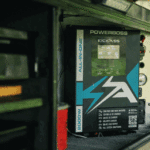Did the turbo-diesel onslaught kill what’s really an economic fuel choice? With diesel priced on par with (or more than) petrol, we re-examine LPG.
Words Colin Young
LPG – Liquefied Petroleum Gas – has long been successfully used as a beneficial ‘alternative fuel’ for cars and trucks; especially those that have a high fuel consumption rate and travel long distances each year. Having slipped off the radar, however, it may well be called ‘the forgotten fuel’.
LPG has significant technical, environmental and financial advantages over petrol and diesel, and has its plusses and minuses for RVers – both for motorhomes and for tow vehicles of caravans.
It is certainly worth considering. While the number of (automotive) LPG refuelling facilities around the country may be widespread, probably having two completely separate fuel systems on board is the preferred way to go.
There are three vital points to carefully consider when adding an LPG system to a vehicle:
- Has the particular brand of system been around for a long time, with proven performance and reliability?
- Does the specific system have a Certified Approval, and will the installation comply with the relevant emissions regulations?
- Has the particular engine been known to perform well when running on LPG, and does the vehicle manufacturer’s warranty remain valid?
Advantages
Abundant local supplies: Vast reserves, without relying on imports.
Cheap: Usually a fraction of the cost of petrol and diesel.
Readily available: Excellent infrastructure, except in remote areas of the country.
Safe
- Extremely strong storage tanks, with safety pressure-relief valves fitted.
- Gaseous fuel – disperses and diffuses; however, gaseous LPG is heavier than air.
- Higher ignition temperature: 470°C compared with 300-400°C for petrol.
- Higher lower-flammability-limit: 1.9% volume in air, compared with 0.6% for petrol.
- Non-toxic (anaesthetic only).
Clean-burning
- Less CO (carbon monoxide) harmful emissions.
- Less HC (hydrocarbon) harmful emissions.
- Less NOx (oxides of nitrogen) harmful emissions.
- No fine particulates (dangerous respiratory) emissions.
- Less emissions during cold starts.
- Simple fuel molecules – less Greenhouse Gas emissions (carbon dioxide).
- The few hydrocarbons formed are not radical and do not form smog.
High octane rating
- Better detonation resistance – delays or stops ‘pinging’ or knocking.
- Permits higher compression ratios – more power for the same fuel flow.
- Permits turbocharging – more power, without engine modifications.
- Slow-burning – smoother power and quieter combustion with less NOx.
Gaseous fuel
- Does not wash lubricating oil off the cylinder bores – less wear.
- Does not get trapped in piston rings to form high hydrocarbons.
- Does not dilute the lubricating oil.
- Does not form carbon – no abrasive carbon in lubricating oil.
- Does not form smoke – even if the mixture is rich.
- Cannot foul spark-plugs – vital for emergency service vehicles.
- No fuel line freeze-up in cold weather – no water in fuel system.
- Mixes quickly with the induction air – more-even air/fuel ratios.
No losses
- No evaporative losses – completely sealed system.
- No pilferage.
Less maintenance
- Longer oil and filter life.
- Longer engine life – no abrasives in oil, no dilution of oil.
- Longer spark-plug life – no fouling.
- Simple fuel system – reliable and very easy to diagnose and service.
Disadvantages
- Conversion cost: However, this cost is recovered due to lower fuel costs, after which the savings are pocketed.
- Lower energy density: Reduced driving range for the same size fuel storage tank. However many vehicles have a sufficient driving range; if not, a bi-fuel system can readily be fitted.
- Additional weight: An LPG tank has to be strong enough to safely withstand the internal pressure, hence thicker and heavier steel is required. LPG tanks have to be cylindrical, with domed ends, because of the internal pressure.
How Long will it Take to Recover the Cost of Conversion?
The payback time depends on a number of items, these being the:
- Cost of the conversion;
- Distance travelled each year;
- Fuel economy (litres/100km) of the vehicle;
- Efficiency of the LPG fuel carburation/injection system;* (See footnote)
- Cost of petrol ($/litre); and
- Cost of LPG ($/litre).
It’s a pity that LPG is not sold in $/kg, rather than $/litre! There are a number of online calculators available, where you can quickly determine the payback period by simply inserting the above figures.
*Because of LPG’s low density – as a liquid – compared with that of petrol, one would think that its fuel economy (litres/100km) would be much worse than it is. Older carburation systems typically had a 30% drop in fuel economy, whereas newer injection systems have a typical drop of around 20%. Some engine designs perform extremely well on LPG, some are not as efficient.
LPG is stored as a liquid (at a moderate pressure, depending on the ambient air temperature), but enters the engine as a gas. This gives ‘the best of both worlds’ – a long driving range is achieved, and combustion efficiency (good fuel/air mixing and clean-burning) is significantly improved.
LPG has a very high ignition temperature; hence it adds even more safety benefits in any accident situation. Of course, there always has to be a downside to any benefit, and in this case it means that a much hotter (higher-energy) spark will be required in the combustion chamber in order to ensure that it ignites every time you want it to.
LPG is technically a superb automotive fuel, from a combustion point of view. It has a very high octane number (up to 110 RON), and fairly low susceptibility to pre-ignition. This means that the fuel can withstand higher compression without detonating. One can actually get something (extra power and fuel economy, in this case) by increasing the compression ratio, or turbo/super-charging the engine.
Because propane is near the top of the hydrocarbon tree, its boiling point is low and its static flame speed is slow. This means that for the best get-up-and-go power and economy, you need plenty of low-down ignition advance; however, you do not get any ‘internal cooling’ with LPG… hence you need to limit the top-end advance. Like unleaded petrol, there is not any lead in LPG; hence hardened valve seats or inserts are required.
LPG tanks are only filled with (liquid) LPG to 80% of their capacity. This is to provide an ‘expansion chamber’ for the liquid fuel, which expands as the temperature (of the outside air, tank and fuel) rises. Liquid LPG expands about 1.5% for every eight degrees C temperature increase.
Unlike a petrol or diesel tank, an LPG tank does not contain any air or water vapour… just liquid LPG at the bottom, and gaseous LPG at the top.
When the engine is running, liquid LPG flows from the tank to the converter/vapouriser, which converts it from a variable high-pressure liquid to a constant low-pressure gas, which then flows to the carburation/injection system.
When liquid LPG vaporises to become gaseous LPG, its volume increases by around 270 times.
LPG Is an Excellent Fuel for:
- Petrol (spark-ignition) engines; and
- Diesel (compression-ignition) engines.
For spark-ignition engines, LPG can be used as:
- Single fuel, or
- Bi-fuel, where LPG is used as the main fuel, but petrol is used as a limp-home back-up fuel or to extend the driving range (in this case, only one fuel is used at any time).
For Compression-Ignition Engines, LPG Can Be Used By:
- Converting the engine to spark-ignition, using LPG as the only fuel; or
- Dual-fuel operation, where diesel and LPG are used concurrently – that is, diesel is used to commence the combustion and LPG is induced into the induction air to supplement the fuel supply to the engine.
For Compression-Ignition Dual-Fuel Engines, Two Alternatives Are Available:
- Leave the diesel fuel system completely standard, and simply add a small amount of LPG (typically around 15% of the total fuel flow) to the induction air. This is an easy but important environmental and ‘good citizen’ first-step introduction to alternative fuels, and provides a modest power increase and fuel cost saving while appreciably reducing the smoke, smell and noise; or
- De-rate the fuel delivery system, and add a much larger amount of LPG (typically up to maybe 70%) to the induction air. This also increases the engine power, and provides a substantial reduction in fuel costs.
Note: It is important to understand what is meant by bi-fuel and dual-fuel. There is much confusion. Originally, and in many overseas countries, the above meanings were (and are) reversed. Dual-fuel LPG/petrol systems are, by the new definition, actually bi-fuel systems… where only one fuel is used at any time.
Spark-Ignition Engines
Preferably, LPG is used as a single-fuel, where the compression ratio and ignition timing can be optimised to provide the best possible performance (power and economy) while ensuring that the engine will maintain excellent reliability and durability. Petrol can be used as a back-up fuel, but it is vital that the ignition timing will not cause engine damage when running on petrol; dual-curve ignition units are available to safely allow petrol to be used as a limp-home fuel.
While propane can usually tolerate a compression ratio of around 11:1 or 12:1 (depending on the design of the combustion chamber), petrol engines will only withstand a compression ratio of typically 9:1 or 10:1 before the cylinder head gaskets fail. Unless a specific engine has sufficient metal to permit the use of metal sealing rings around the bores, it is not wise to increase the compression ratio significantly when a petrol engine is adapted to LPG use.
Compression-Ignition Engines
Converting to a spark-ignition engine requires the injectors to be replaced by spark-plugs, the injector pump to be replaced by a distributor, and the compression ratio to be lowered. Some diesel engines lend themselves better to this conversion than others; lower-compression, higher-revving engines provide the best efficiencies. Diesel engines are way over-engineered for spark-ignition applications; hence their reliability and durability is exceptionally high.
The compression ratio can be lowered by either using thick cylinder-head gaskets, or by machining metal from the combustion chambers in the cylinder head or from the top of the pistons; this latter method can often improve the engine power and economy by providing a better shape of combustion chamber. In some engines, it may be desirable to re-grind the camshaft to provide an improved valve-timing pattern to best suit the particular engine and driving usage characteristics.
Adapting a dual-fuel system does not alter the basic diesel fuel system. There are no spark-plugs, and diesel is still always used to ‘start the fire’ and keep the engine idling. However, as the engine speed increases above idle (as the driver depresses the accelerator), the control system:
- Reduces or limits the amount of diesel injected into the engine; and
- Progressively increases the amount of LPG induced into the engine.
The LPG is introduced into the inlet manifold at a slight positive pressure. Some dual-fuel systems employ a throttle in the inlet manifold as part of the fuel metering control system. As the percentage of LPG increases, and the percentage of diesel correspondingly decreases, the fuel cost savings – along with the engine power – increase.
However, the critical consideration (in terms of engine reliability) is how much fuel substitution can be safely tolerated before detonation and over-heating occurs. This percentage depends very much on the particular engine design, and the type of engine operation. Stationary (constant-load, constant-speed) engines like generators and pumps can typically tolerate a 95% substitution rate; that is, at any time the engine is concurrently using 5% diesel and 95% LPG. Road vehicles, with their continually changing engine speed and loading, are usually limited to a 70% to 75% substitution rate; however this still provides worthwhile financial and technical advantages.












